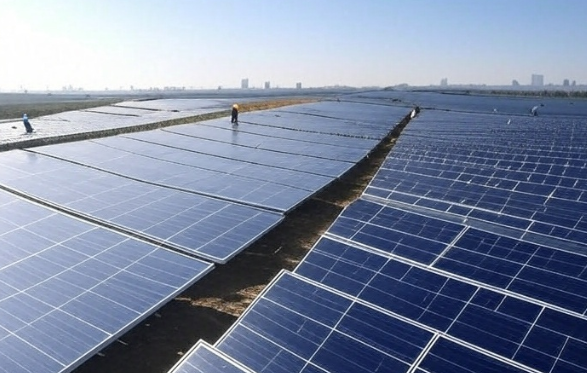China added 256 GW of solar in just six months of 2025, reshaping the global energy race. India, with vast potential and 123 GW capacity, is striving for energy independence and clean power exports by 2030.
China’s Solar Sprint of 256 GW in 2025
In a feat that highlights its undisputed dominance in the clean energy sector, China has installed an astonishing 256 gigawatts (GW) of solar capacity in just the first half of 2025—more than double the combined additions of every other country in the world. This explosive growth pushed global solar installations to a record 380 GW in the same period, marking a 64 percent surge compared to 2024. Beyond being a technological triumph, this shift underscores a major geopolitical transformation as nations race to secure energy independence in a volatile global landscape.
For India, with its vast solar potential and rapidly growing economy, the Chinese model serves as both a warning and a call to action: harness the power of the sun to achieve self-sufficiency, build cross-border energy networks, and emerge as a clean power exporter.
China’s solar story is nothing short of a juggernaut. According to Ember, a leading energy think tank, Beijing’s solar additions made up 67 percent of the world’s total in the first half of 2025, dwarfing the 124 GW installed elsewhere. To put this in perspective, China alone added more solar capacity than the rest of the world combined. In May 2025, China added a record-breaking 93 GW in a single month, equivalent to installing around 100 solar panels every second.
This rapid pace was partly driven by developers rushing to complete projects before new renewable compensation reforms came into effect in June. Yet industry experts, including those from the China Photovoltaic Industry Association, project that the country will still manage to add between 215 and 235 GW by the end of the year, easily surpassing 2024’s record.
Several factors explain China’s remarkable surge. Industrial might plays a key role, with the country producing 80 percent of the world’s solar panels. Exports of cells and wafers jumped by 76 percent year-on-year, ensuring both low costs and global dominance. Policy measures also created momentum, from mandates requiring industries to procure clean power to significant investments in transmission and grid capacity, which rose 22 percent in the first half of 2025.
The climate payoff is already visible: wind and solar together overtook hydropower for the first time in Chinese history, cutting emissions and generating 270 terawatt-hours (TWh) of clean electricity, which outpaced the country’s demand growth.
On social media platforms like X (formerly Twitter), China’s clean power sprint has fueled debates across the globe. Indian MP Shashi Tharoor amplified the message by calling for India to “blanket every bit of barren land” with solar panels, while energy experts highlighted China’s staggering 12 times lead over the United States. The consensus is clear—China’s scale is not just technological, but also a statement of global intent.
India, meanwhile, is making steady strides of its own. With 24 GW of solar capacity added in the first half of 2025—a 49 percent jump from last year—it has overtaken the United States to become the world’s second-largest installer. As of August 2025, India’s total solar capacity stands at 123.13 GW, according to the Ministry of New and Renewable Energy.
The country’s potential is immense, with the National Institute of Solar Energy estimating that 748 GW could be generated from just 3 percent of India’s wasteland. With over 300 sunny days a year, the opportunity is unmatched. Rajasthan and Gujarat remain the frontrunners, hosting mega-projects like the 2.2 GW Bhadla Solar Park, but growth is spreading nationwide—from high-altitude panels in Ladakh to hybrid coastal projects in Tamil Nadu.
India’s progress is being powered by a mix of strong policy support, rising investments, and innovation. The revised 100 GW Solar Mission has set ambitious targets for both rooftop and park-based projects, aiming for 40 GW rooftop capacity by 2026 and around 38 GW through solar parks by 2025-26. Investment flows are robust, with US$16.5 billion in 2024 and plans to reach US$360 billion by 2030 in pursuit of 500 GW non-fossil capacity.
Private sector commitments are growing too, with Tata Power announcing Rs 70,000 crore investments for 10 GW projects in Tamil Nadu. Innovations like floating solar installations in Telangana and large-scale green hydrogen projects targeting 5 million tonnes production by 2030 are also diversifying India’s renewable mix.
However, challenges remain. Grid integration for variable renewables, land acquisition hurdles, and dependence on Chinese supply chains are persistent concerns, though domestic manufacturing capacity has risen to 36 GW in fiscal year 2024. Market watchers on X continue to spotlight opportunities—Indian investors discuss solar stocks such as Alpex Solar, while regional energy trackers emphasize the long-term boom expected by 2030.

Looking ahead, India’s ambitions go beyond self-sufficiency to becoming a clean energy exporter. The 485 GW National Grid, one of the world’s largest synchronous networks, is evolving into a transnational system. Plans are underway for a 7,000 km super grid connecting Saudi Arabia to Vietnam, positioning India as the hub of an Asia-spanning energy corridor.
Cross-border electricity exports to Nepal, Bangladesh, and Myanmar are already operational, while imports from Bhutan complement domestic needs. The One Sun One World One Grid initiative aims to expand these links to Myanmar and Thailand.
By 2030, India could emerge as a net exporter of clean power, driven by 280 GW of solar capacity and domestic module manufacturing scaled up to 100 GW annually by 2026. Green hydrogen, supported by a US$2.4 billion National Mission, could add another layer of exports. Grid operator Power Grid Corporation is targeting 50 percent internal renewable use by 2025 and net-zero operations by 2047. Investments in battery storage—expected to reach a US$32 billion market by 2030—will ensure stability as renewables expand.
Partnerships are also growing, with companies like Suzlon achieving a 1 GW wind milestone in collaboration with Torrent Power. Covering areas like the Thar Desert and the Deccan Plateau with solar projects could unleash hundreds of additional gigawatts of power, echoing Tharoor’s viral call for a national solar revolution.
China’s 256 GW solar sprint demonstrates that speed and scale are decisive in the clean energy race. India, with ten times the growth potential still untapped, has the chance to leapfrog by accelerating domestic manufacturing, strengthening its power grid with storage and hybrid systems, and investing US$190-215 billion in renewable infrastructure over the next few years.
The benefits are enormous: energy security, millions of green jobs, and positioning India as a clean power exporter by 2030. As Shashi Tharoor aptly put it, “Let’s blanket every bit of barren land for clean energy.” The sun is shining, and India must act decisively to capture it.

